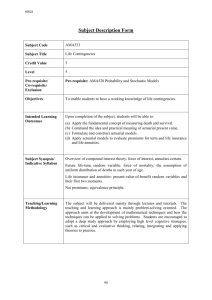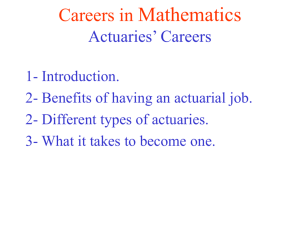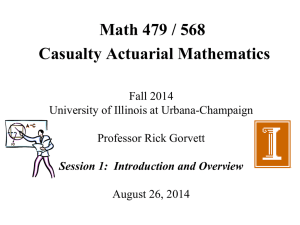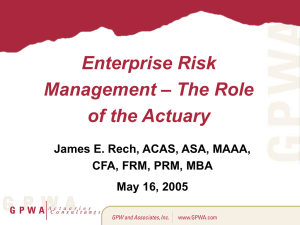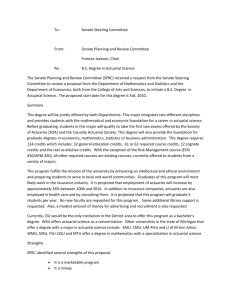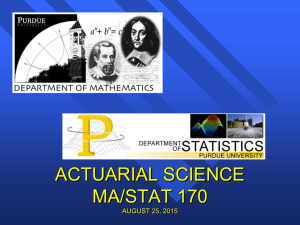The Actuarial Profession:
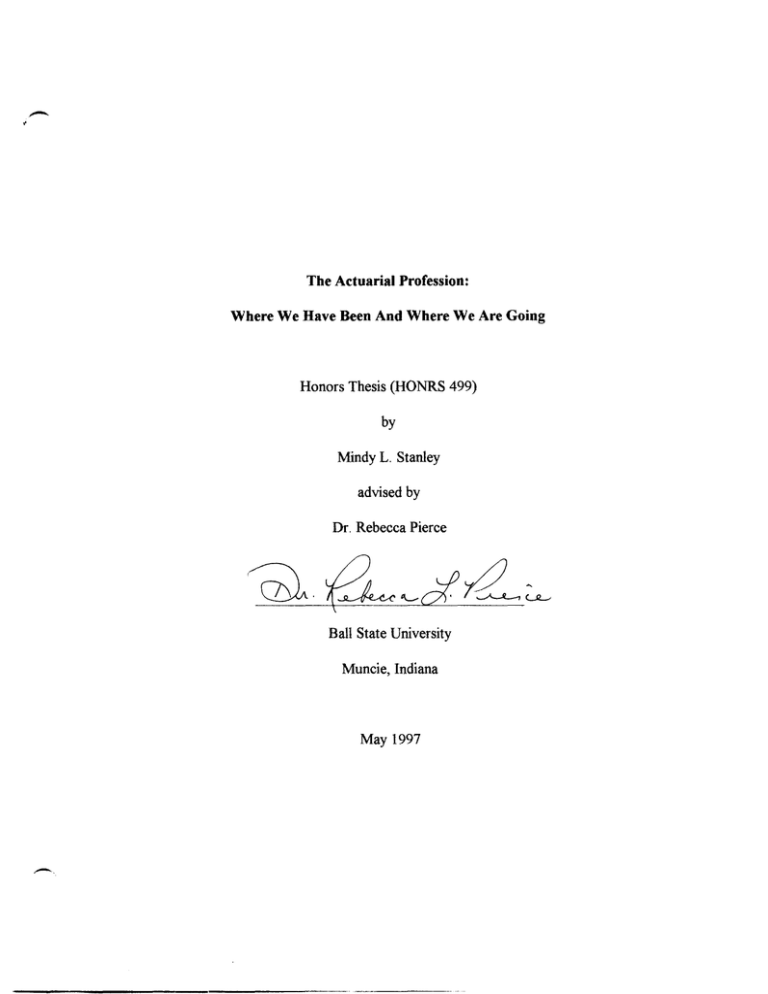
--
The Actuarial Profession: Where We Have Been And Where We Are Going
Honors Thesis (HONRS 499) by Mindy L. Stanley advised by Dr _ Rebecca Pierce Ball State University Muncie, Indiana May 1997
I .' 1 Acknowledgements I want to say 'thank you' to all of the people that have impacted me, both academically and personally, while at Ball State. Thank you to the teachers who have not only challenged me, but who were also willing to help me ifl was struggling. I want to give special thanks to Dr. Rebecca Pierce and Mrs. Linda Hall for being not only my instructors and advisors, but also my friends. Mindy L. Stanley
2 Introduction The actuarial profession seems to be a mystery to the general public. I can't count how many blank stares and befuddled looks I have encountered when fielding the question ''What's your major?" I rarely say "actuarial science" once without having to repeat it for the benefit of the listener. It is difficult to say why actuaries, who have such a significant role in the sheer survival of any insurance company, and who have a major influence in business and government in general, go so unrecognized by the public. Maybe the reason is that actuaries' work is not immediately apparent to the casual observer. However, the accounting department is relatively invisible in most companies, and yet everyone knows what an accountant is. The purpose of this paper is to shed some light on the actuarial profession. It includes a brief history of the development of the profession and a discussion of current trends and issues affecting actuaries today. From now on, I am just going to carry around copies of this paper and hand one to anyone who asks, "What's your major?"
3 From the Beginning " ... [E]ssentially the actuary's concern is to apply mathematics and accumulated experience to risks and contingencies, making uncertainty less uncertain, and doing it with the highest degree of professional responsibility" (Mitchell 1974). This definition gives a feel for what an actuary does, but it by no means encompasses the scope of the actuarial profession. Although actuaries have primarily been involved in the insurance industry, they also work as consultants to many businesses, large and small, and in government. They have a large effect on such social programs as Social Security and Medicare and on benefit packages offered by businesses to their employees. Although insurance has existed for thousands of years, the actuarial profession is only about two hundred years old. The need for actuarial expertise first arose in Great Britain, during its great upsurge to power. As prosperity increased, so did the need for life insurance. However, only very crude forms of life insurance were available (Mitchell 1974). All of the basic ingredients for whole life insurance were already floating around the mathematics and science disciplines. These ingredients included: probability (in terms of dice and cards), life expectancy tables, birth and death statistics, and annuity and compound interest calculations. The first person to put all of these components together to create a mathematically sound basis for insurance was James Dodson (Mitchell 1974). He showed how to develop a plan for permanent life insurance, complete with premium and reserve calculations (Mitchell 1974).
4 After Dodson's death, his infant business, Equitable Life Assurance Society, was taken over by Edward Mores. Mores created the designation "actuary" for his administrative position, possibly alluding to a designation in the Roman Senate for a person who kt:pt records of the Senate's sessions for publication in the daily gazette. At first, the term "actuary" applied to the people making important decisions in the insurance industry, and outside mathematicians were hired to do calculations. A key person in Equitable'S early history, Dr. Richard Price, brought into service his nephew, 'William Morgan, who has since been regarded as the father of the actuarial profession (Mitchell 1974). Morgan was the first person to combine actuarial functions with the designation "actuary". The actuarial profession attained legal recognition in 1819 with an act of Parliament. John Finlaison served as the first government actuary when he was appointed to the position in the National Debt Office. Despite the legal recognition of actuarial science as a profession, most insurance companies went on about their business without actuarial expertise. As a result, insurance companies came and went very quickly because they were not able to remain solvent. It was during this time, the first half of the nineteenth century, that actuaries recognized the need for an organization to develop and promote actuarial techniques. The first ofthese professional societies was the Institute of Actuaries, which was established in London in 1848. John Finlaison was the first president of this organization. The Institute stressed examination and training to obtain professional status and meetings to discuss issues and problems (Mitchell 1974). The Aetuarial Club was also formed at this time as an exclusive club, meant for only the most influential and important actuaries in practice. It was created in retaliation
5 to the Institutc:::, which allowed anyone to make attempts towards professional status. The Actuarial Club focused mostly on the formulation of practice, and they conducted a few investigations of limited scope (Mitchell 1974). These two organizations finally merged in 1884, and the Institute of Actuaries received its royal charter. The first professional organization for actuaries in America came into being in 1889 in New York City and was known as the Actuarial Society of America. The thirty eight original eharter members included both Canadians and Americans. From the beginning the Actuarial Society of America has had very high standards, both professional and personal, for membership. Admission by examination was implemented in 1896, with the two designations of Associate and Fellow. The examination process and the society itself greatly benefited insurance companies, and the industry as a whole, because companies were able to hire young professionals with proper training and experience (Mitche111974). Another major benefit to the industry was that now many actuaries could pool their resources. Not only could they put their heads together, but they could also combine their historical mortality data. Mortality and experience tables became much more accurate because of larger pools of data. Throughout the twentieth century there have been many landmark developments in the actuarial profession. One of the first of these important developments was the formulation of a numerical rating method of risk evaluation. Previously, most life insurance companies wrote only standard risks, lives which had a strong chance at long term survival. However, numerical rating for risks made it possible to insure higher risk lives because eompanies could calculate how much above the standard premium rate to charge for the policy. Numerical rating was based on assigning weighting factors for
,-
6 different risks to calculate a policy premium. This rating system was made possible largely because of the reliability of mortality tables (Mitchell 1974). Anoth(!r significant advance in actuarial science, and one that also had positive effects on the medical and scientific professions, was the development of inter-company specialized mortality studies. Although the Actuarial Society of America had made strides in the insuranc:e industry by pooling its members' resources, the Specialized Mortality Investigation, conducted from 1901-1903, was the most comprehensive mortality study ever undertaken (Mitchell 1974). It pooled experience on ninety-eight classes of risks from thirty-eight companies, classified by factors ranging from amounts insured, to personal and family history, nationality, and place of residence (Mitchell 1974). In the next few years. several more extensive studies followed. These studies accumulated an unprecedented body of knowledge about mortality incidence, and it improved the scientific basis for substandard underwriting. In the learly part of the twentieth century, more and more insurance companies started cropping up in the Midwest and the South. With this growth in the insurance industry came a high demand for qualified actuaries. However, the supply was limited both in numbers and geography. The Actuarial Society of America was located in New York, and sinc:e that is where the concentration of insurance companies had been, that is where most ofthe actuaries were located. As a result, many of the actuaries in midwestern and southern companies were not actuaries at all, in the professional sense, but had gained actuarial skills through on-the-job training. Also, many of these actuaries had a different skill orientation than did those in the East. Whereas the eastern companies were all mutuals, many new companies were stock-traded, non-participating companies.
7 These companies did not have the advantage of over-conservative policy pricing, with the idea that excess premium dollars would be refunded to the policyholder as a dividend, as did the mutual companies. This pattern created a need for another professional organization to address the issues, problems, and skills of a growing and widely varied profession (Mttchell 1974). The ne:ed was filled in 1909 with the creation of the American Institute of Actuaries, headquartered in Chicago. Although a sense of competition between the Actuarial Society of America and the American Institute of Actuaries might have been natural, it did not occur. Both groups cooperated on various studies, publications, meetings, examinations, and education (Mitchell 1974). Soon after the formation of the American Institute of Actuaries came the advent of group insurance. Most workers were too poor to even purchase burial insurance, and many companiles were coming under public scrutiny for their unethical practices. It was during this time that companies began to realize the importance of developing positive relationships with their employees. The first company to consider group insurance was Montgomery Ward in Chicago (Mitchell 1974). Their negotiations with the Equitable were long and arduous, but the creation of group insurance, in the technical sense, was not too difficult. The biggest obstacle, aside from what rates to charge, was how to deal with the aspect of anonymity, which is the premise of group insurance. They had to learn how to treat the group as a single entity, not as many individuals (Mitchell 1974), Anothc~r product of the growing social consciousness of the early twentieth century was worker's compensation insurance and the development of the Casualty Actuarial Society. The government enacted laws which set up a schedule of payments for
8 a worker who was injured on the job, regardless of negligence. The actuarial techniques and assumptions involved in worker's compensation were much different than those oflife insurance, and several actuaries reacted by forming the Casualty Actuary and Statistical Society of America in 1914. (In 1921 it was renamed the Casualty Actuarial Society). As casualty actuaries became interested in more than worker's compensation, the group was expanded to include all types of insurance except life insurance (Mitchell 1974). During the Depression, actuaries learned a hard lesson about disability income insurance, which was often offered as a rider on life insurance. The rider provided $10 per month in disability income after a 90-day waiting period for a presumably permanent disability. Be<:ause of the Depression, many people with disability insurance found that if they could get certified as "disabled", they were better off than trying to work. This situation caus(!d actuaries to rethink this type of insurance, and they realized the importance of setting benefits at a rate low enough to discourage fakery (Mitchell 1974). As the actuarial profession grew during the mid-twentieth century, actuarial employment and influence in government greatly increased. This was especially true with the implementation of Social Security. Today the Chief Actuary of the Social Security Administration is regarded as the highest government actuarial post (Mitchell 1974). Government actuarial positions were also present in the Operations Research Group set up by the U.S. Navy in 1942. Actuaries used their expertise to calculate life expectancies of various water crafts (primarily submarines), along with the probability of being attacked in various situations, and the best attacking methods. During the course of this research, actuaries were able to use Electronic Data Processing for many of their
9 studies, which allowed them to do computations that would previously have been impossible in terms of time and manpower (Mitchell 1974). A major landmark in actuarial history was the formation of the Society of Actuaries. It was formed through a merger of the two previously existing organizations, the American Institute of Actuaries and the Actuarial Society of America, and it is probably the most well-known and influential actuarial organization today (Mitchell 1974). The formation of the Society allowed for the pooling of resources and talent, and it created a uniform examination process. The Society publishes its proceedings, including papers accepted and reviews of them, in the Transactions. It also distributes a monthly newsletter to its members called The Actuary (Mitchell 1974). Throughout the 1940's and 50's, the actuary as "consultant" gained notice and popUlarity. The primary area for consultants was with companies who needed professionals to design, implement, and oversee their employee benefit plans. Consultants also found a niche in working for smaller insurance companies that did not have many or well-trained a(;tuaries on staff. Actuaries were also hired to do periodic, unbiased reviews of companies that did have actuaries on staff. In 1950, some consultants organized as the Conference of Actuaries in Public Practice, which is based on credentials rather than examinations (Mitchell 1974). Consulting demand continues to grow with the implementation of more comprehensive and complicated group employee benefits packages. The last several decades have seen many innovations in products offered by insurance companies. Since actuaries are behind all new products, creating them such that they are profitable, feasible, and actuarially sound, actuaries have had many challenges in
., 10 the area of product rollout. Among the newer products in the life field are variable life, universal life, variable-universal life, and many different types of policy riders, including guaranteed insurability provisions and family income riders. The casualty field has seen increased competition in many of their lines of business, especially automobile liability insurance. Insurance companies have been forced to take aggressive underwriting measures in order to lower premium costs, and thus compete in the market. Another important devdopment in casualty insurance was the advent of the comprehensive homeowner's policy. This policy encouraged people to purchase more than just basic fire insurance to cover their home, as extended coverages purchased separately were more expensive (Mitchell 1974). F or all of the progress made in the actuarial profession, one element is still elusive - public recognition. One way that actuaries have attempted to deal with this problem is through the accreditation body created in 1965 called the American Academy of Actuaries. This organization oversees the actuarial profession, admits members on a very strict basis, promotes professionalism and integrity in practice, and takes disciplinary actions against members who do not live up to the Academy's standards (Mitchell 1974). The Academy has been instrumental in giving credibility and visibility to the actuarial profession. However, actuaries as a group still have a long way to go to achieve widespread public recognition and respect. Changing Times As the business world changes, so does the actuary's role in it. Over the past couple of decades, the role of the actuary has evolved in two main ways. First, actuarial
11 skills are being demanded far beyond the reaches of traditional actuarial functions. Secondly, more is being asked of the actuary as a professional. The influence of the actuary is expanding beyond the traditional insurance, consulting and government posts. One major area of growth for actuaries is in the banking and financial industries. Currently, actuaries are involved with banks, brokerage firms, thrifts, and virtually all other types of financial institutions (Peabody 1994). The banking industry, like insurance, is based on risk. Banks benefit by being able to project future credit, market and other risks associated with their vast array of products and services. ''Fundamentally, actuaries deal with risk, and the measurement and application of that risk in business situations" (Peabody1994), so actuaries are well-equipped to handle the concerns of the financial industries. Many of the concerns that banks face are similar to what actuaries have been dealing with in insurance for years. Specifically, banks struggle with maintaining strong earnings and adequate capital in an ever-changing economy, increased market competition, and constant changes in regulations. Just as insurance companies must meet certain requirements for reserves to cover losses, banks must also keep loan loss reserves to cover defaults of debtors. Calculation of these requirements relies on historical data analysis, an actuary's specialty. Actuaries also assist banks with product profitability analysis. Again, historical experience comparisons help to predict future profitability. Other projects for actuaries include assistance in evaluation of companies involved in mergers and acquisitions, risk-based capital analysis, data analysis, and experience studies (Peabody 1994).
12 Even within traditional actuarial jobs, the scope of the actuary is being greatly expanded. Actuaries have long dealt with the perception of being robots, back-room technicians who sit and crunch numbers day-in and day-out. The actuarial profession is working to dissolve this perception by developing useful business skills to supplement their technical expertise. The tightening of the job market for qualified actuaries is pushing them to become well-rounded business people, complete with strong verbal and written communication, creativity and a forward-minded business sense. Actuaries with these attributes are quickly expanding their influence both within and outside of the insurance business (Jones 1991). The Actuary of the Future Task Force of the Society of Actuaries has identified the following high potential roles for actuaries in insurance: chief financial offic(~r, treasurer, product line manager, controller, and strategic planner and marketing specialist (Jones 1991). Some actuaries are also getting involved in the investment side of the business. Actuarial organizations are becoming dynamically involved in the metamorphosis of the profession. They recognize the need for keeping up with the times in terms of training and continuing education. The Society of Actuaries has implemented elective investment courses in its syllabus, and it is providing training in such non-technical areas as public speaking and management (Bartlett 1991). One major obstacle that actuaries face in career expansion is developing the ability to present their knowledge and skills on a level that is useful to the company. In other words, actuaries must learn to put their technical jargon into a language that can be understood by the people they interact with. They must also learn to find practical applications for their technical skills (Jones 1991). Actuaries must present themselves as
. 13 diversified business professionals with the added bonus of a specialty skill not possessed by many other people. Two more recent areas of influence for actuaries in insurance are systems design and product rollout. Actuaries must be increasingly proficient in computer technology to keep up with all ofthe new equipment at their disposal. New tools are being constantly developed which make work more efficient and results more accurate. Modeling tools are more sophisti(:ated, graphics programs are being simplified, new PC-based spreadsheets are coming available, and networks are being developed which allow greater access to corporate information (Burger 1993). Aside from keeping on top of the constant changes in these areas, actuaries are more often being asked to contribute to the development of in-house systems design. For some time now, actuaries have done their own programming. They have been able to meet their own needs, but they have taken themselves out of the mainstream, from an information services (IS) point of view, because they have continued to use arcane programming languages such as APL. Although APL remains the language of choice for many actuaries, they are now trying to get back into the mainstream by learning the languages, sU(:h as Jtools, used by IS, and adapting those languages to handle the volume of information required for much of their work. A good relationship with corporate IS is beneficial to aetuaries because IS is responsible for obtaining all equipment and software, and they centrally determine what equipment and programs will be used throughout the company (Burger 1993). Actuaries work closely with corporate IS to develop systems that generate the type of data needed to perform their functions .
- 14 As for product rollouts, it is true that actuaries have always been involved in product development and pricing. However, actuaries have not always had much say at the decision-making level. Instead, most decisions about which products should be pursued, and how, were influenced almost exclusively by producers (agents) and marketers (Koco 1994). It used to be that people in close contact with the market just told actuaries what was needed, and they were expected to develop it. Sometimes, new products were: put into the market with little to no actuarial involvement at all. Now many actuaries claim that their opinion of and involvement in new products is more highly regarded by other people involved in the process (Koco 1994). One reason for this trend is the downfall of several major insurance companies in the past few years. Now companies are re-examining their products to see what effect they are really having on their financial position. Evaluation of product pricing requires the hand of an actuary. Other reasons include ''the rise of risk-based capital requirements, the imminence of Triple-X regulations (which will tighten reserve requirements), and the emergence of numerous highly complicated variable products" (Koco 1994). Many new products carry the trademark of actuaries. They are more explicitly defined in terms of coverages and exclusions. The use of more precise language makes parameters of coverage clearer, and therefore experience is easier to control and predict. As a result, however, policy language has become more difficult for laypersons to understand, and formulas used for determining "everything from sales loads and commission levels, to death benefits, and annuitization values", have become much more complicated (Koco 1994). But overall, products created by actuaries are likely to do better in the market than products implemented without their influence.
15 Like the insurance actuaries, consulting actuaries are experiencing many changes in their profession. Consultants have always needed to have the skills to communicate well with clients and be able to work well with other people in the office. However, actuarial consultants are now being looked at less as actuaries, and more as business partners. They are expected to understand all facets of their clients' businesses and industries and be able to tailor their services to meet the goals and the needs of each individual client. Many consulting firms now offer a variety of services to their clients, sort of a "one stop shopping" approach. For example, Towers-Perrin, one of the Big Four retirement consulting firms, advertises "multi-faceted, integrated services". They offer ''broad business expeltise [along] with specific functional skills across six business areas: retirement; health and welfare (group benefits); compensation; human resources and communication; general management; and workers compensation and risk management" (Towers-Perrin - Your Career in Consulting). This trend is likely a result of increased market competition. Consulting firms try to retain business by providing as many services as possible, reducing companies' need to use several different firms for projects in different areas. Just because firms are offering many different services does not mean that actuaries must now become experts in all of these areas. However, they must have a general understanding of the work done by other people in the company and be aware of how those people's services might be useful to their clients. Another reason that consultants must work extra hard to develop a strong business relationship with their clients is that some of their traditional functions are becoming obsolete with the development of new technology. This is especially true for pension
16 actuaries. There now exist software packages and web sites that clients can use to gather and analyze the data and infonnation about their plans for which they used to hire consultants. As a result, consultants have adapted their approach to clients as one focused on problem solving and interpretation of data (Cardona 1996). The technology trend in pension evaluation is beneficial to both the client and the consultant. Hecause consultants are freed up from some of the tedious data manipulation, they are able to focus on the more challenging issues of plan management and take on more sophisticated projects for their clients. Since clients have more access to information about their plan, they are able to become bigger players in the decision making process (Cardona 1996). Clients rest easier when they do not have to follow their actuary's advice on blind faith. At the same time, they generally have more questions to ask their actuaries about the significance of the infonnation they gather, so the client-consultant relationship becomes mort:: of a partnership than a dependency. A new area of expansion in actuarial consulting is that of healthcare. The new healthcare environment, in which hospitals, physicians, and managed care firms are entering into many types of at-risk contracts, is dramatically increasing the demand for qualified healthcare actuarial consultants and consulting finns (Schachner 1995). Healthcare providers ranging from hospital and doctor groups to governments are needing to analyze future business cost and the adequacy of contracts with managed care providers (Schachner 1995). Major consulting firms are hiring healthcare actuaries like never before, and some are even training pension actuaries in healthcare techniques. Healthcare will likely remain a hot area for actuaries as long as the healthcare environment is in a state of change.
17 National Issues and Actuarial Opinion Two hot issues in government for the past few years have been the healthcare system and the retirement system. Politicians have been calling for healthcare reform to provide more affordable health care to more people, and everyone is starting to see the problems this country is going to run into when the baby-boomers reach retirement age. Actuaries are in a position to have a big impact on the developments in both of these areas. For example, if health care reform ever gets rolling, health actuaries will be involved in designing the plan to meet its' technical objectives (Schwartz 1993). Actuaries will act as the non-partisan, objective third party, giving advice on the consequences of certain pieces of the legislation. In 1996, the American Academy of Actuaries released a report criticizing both President Clinton's and the G.O.P. 's proposals for Medicare reform. They declared both to be fiscally flawed, based on unrealistic scenarios for generating Medicare savings (Brostoff, Actuaries: Clinton. 1996). Although the Republicans' plan allows for more fiscal control than does the President's, both plans have significant deficiencies that will end up costing the program more in the end. The retirement system, including Social Security, has also been a topic of much debate recently. People are fearing the inevitable bankruptcy of the Social Security trust, and they are looking for solutions. Actuaries, too, are calling for an overhaul of the retirement system (Reilly 1994). In 1994, the American Society of Pension Actuaries (ASPA) released policy papers on the issue. Basically, "[t]he papers advocate discarding the qualified plan rules and replacing them with a mandatory pension system, encouraging
18 personal savings by altering the section 401 (k) and IRA rules, offering income tax credits to encourage the employment of older workers, and overhauling the Social Security system" (Reilly 1994). The actuarial profession has taken a close look at the faltering Social Security system. Several alternatives exist which will solve part or all of Social Security'S long range financial problems. Most of them involve combinations of contribution and benefit manipulations" such as lowering the cost of living adjustment, raising the payroll tax, increasing coinsurance and decreasing benefits (Brostoff, Actuaries Scrutinize, 1996). Other alternatives include raising the retirement age to seventy, privatizing or partially privatizing the system, increasing the limit on earnings subject to taxation, and diverting "extra" payroll tax collected in the present (ie. the amount above what is needed to meet current obligations) into individual retirement accounts (Brostoff, Actuaries Scrutinize, 1996). Experts disagree markedly on the solution to the retirement system crisis. As of July 1996, the Social Security Advisory Council was mulling over three possible methods of diverting the looming crisis in the system. There are three basic approaches: traditional, moderate, and non-traditional. The traditional approach proposes to raise revenues by investing forty percent of the trust fund in the stock market, rather than government bonds. The moderate approach would seek to raise revenues and lower benefits, but would also include mandating 1.6 percent of payroll into IRA's. Finally, the more radical approach would reallocate the current payroll tax, using 2.4 percent of payroll to maintain survivor and disability benefits, 5 percent to support a flat benefit not
19 based on earnings, and 5 percent mandated to a defined contribution plan controlled by the individual (Fisher 1996). These are just some of the ideas being tossed around in government to solve our nation's retirement and healthcare problems. All of the possible solutions are going to have many obstacles to overcome in design and implementation. However, it is a pretty sure bet that actuaries are going to be major players in this process. An idea, no matter how good in theory, cannot be put into action without a sound actuarial basis. Conclusion As this paper demonstrates, the actuarial profession has a very distinguished history and a very bright future. I feel that the world today is a very exciting place to live and work. Everything is changing so fast that there are always plenty of opportunities for willing individuals to grow and change with it. No occupation is exempt from the need to be flexible and to adapt to new situations and demands. New technology and new ideas about how to do business are forcing professionals and non-professionals alike to develop new skills and be willing to expand into other areas or change the focus of their work. The actuarial profession is no different. Although we possess much needed technical skills, we must learn to market them and use them in a total business concept in order to be successful. People are skeptical of what they do not understand, and if actuaries continue to bombard the world with technical jargon incomprehensible to the average individual, they will never gain the credibility and respect which they very much deserve. The business world is gravitating toward a team concept, all the way from top management to entry-level professionals. Actuaries, therefore, must learn to be strong
- 20 team players. An actuary with strong technical abilities and good personal skills will likely always have a job.
21 Works Cited Bartlett, Daphne. 1991. Actuaries facing an era of evolution. National Underwriter Life & Health - Financial Services Edition 22 (June): 23,25. Brostoff, Steven. 1996. Actuaries: Clinton and GOP Medicare plans are flawed. National Underwriter Life & Health - Financial Services Edition 2 (January): 14. Brostoff, Steven. 1996. Actuaries scrutinize Social Security. National Underwriter Life & Health - Financial Services Edition 18 (April): 34,38. Burger, Katherine. 1993. Actuaries confront a more complex equation. Insurance & Technc~ 18 (March): 38-42. Cardona, Mercedes M. 1996. Consultants forced into new roles. Pensions & Investments 24 (December): 27. Fisher, Mary Jane. 1996. Panelists debate Social Security funding proposals. National Underwriter Life & Health - Financial Services Edition 28 (July): 9. Jones, David C. 1991. Better 'people' skills a must for actuaries. National Life & Health - Financial Services Edition 22 (June): 23,26. Koco, Linda. 1994. The actuarial voice can be heard in product rollouts. National Undef1writer Life & Health - Financial Services Edition 17 (April): 13,14. Mitchell, Robert B. 1974. From actuarius to actuary: The growth ofa dynamic profession in Canada and the United States. Society of Actuaries. Peabody, 1. L~mn. 1994. Bank financial analysis: an actuary's-eye view. The Bankers Magazine 177 (November-December): 53-56. Reilly, Meegan M. 1994. Pension actuaries advocate retirement system overhaul. Tax Notes 64 (August): 641. Schachner, Michael. 1995. Get more health care actuaries, stat!: Provider practice growth puts new demands on consulting firms. Business Insurance 29 (December): 20.
22 Schwartz, Matthew P. 1993. Actuaries could have vital reform role. National Undenwiter Life & Health - Financial Services Edition 44 (November): 65.
1
